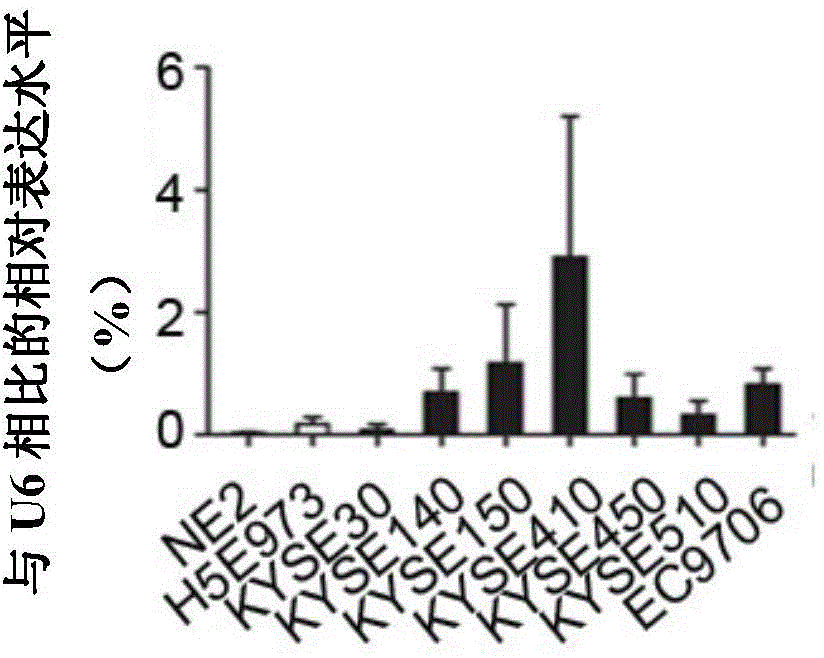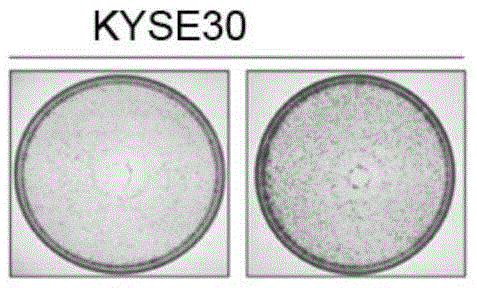Use of microRNA-548k inhibitor in treatment and/or prevention of esophageal squamous cancer
1. The technology of microrna-548k and inhibitors, which can be applied in gene therapy, microbial measurement/testing, biochemical equipment and methods, etc., and can solve problems such as the research of unreported functions
- Summary
- Abstract
- Description
- Claims
- Application Information
AI Technical Summary
Problems solved by technology
Method used
Image
Examples
Embodiment 1
[0030] Example 1: Method for detecting microRNA-548k gene expression
[0031] 1. Extraction of total RNA from sample-Trizol method to extract total RNA from tissues and cells
[0032] (1) Sample processing (bacteria and cells do not need to be ground);
[0033] Break the tissue sample about 1cm2 in aluminum foil, transfer it to the Eppendorf tube with steel balls, and grind it with a grinder (301 / s, 8min)
[0034] Note: This step should be operated in a low-temperature liquid nitrogen environment as much as possible, bacteria and cell samples do not need to be ground.
[0035] (2) Add 1ml Trizol to the ground Eppendorf tube, shake and mix;
[0036] (3) Move the mixed solution to a new Eppendorf tube, add 200μl chloroform, shake and mix;
[0037] (4) Centrifugation: 4°C, 12000rpm, 15min;
[0038] (5) Transfer the supernatant after centrifugation to a new Eppendorf tube, add 500 μl isopropanol, mix gently, and let it stand at room temperature for 15 minutes;
[0039] (6) Centrifugation: 4℃, 1...
Embodiment 2
[0068] Example 2: The expression level of microRNA-548k in human esophageal cancer cell lines
[0069] Real-time PCR was used to detect the expression of microRNA-548k in esophageal squamous cell carcinoma cell lines and normal esophageal cells (see figure 1 ). Among them, the abscissa represents normal cell lines (NE2 and H5E973) and human esophageal cancer cell lines. Compared with normal cell lines, the expression level of microRNA-548k in human esophageal cancer cell lines increased.
Embodiment 3
[0070] Example 3: The effect of changing the expression of microRNA-548k on cell growth
[0071] In this embodiment, the antisense nucleic acid complementary to the microRNA-548k sequence is used as an inhibitor; in the case of "mimicry", the expression level of microRNA-548k in the cell is increased by transfection with the same sequence as microRNA-548k. In the case of inhibitors and mimicry, the expression level of microRNA-548k in cells was down-regulated by about 2-11 times, or up-regulated by about 50,000 times. In the case of the miR-NC negative control, the microRNA sequence transfected into the nematode is used, because it is not homologous to humans and humans have no related mircroRNA, so it can be used as a negative control.
[0072] In KYSE30, KYSE150 and KYSE410 cell lines, the effect of up-regulation of microRNA-548k level on the growth curve of the cell line was tested. Count 2000 cells respectively and inoculate on 96E-Plate, and put the inoculated E-Plate into th...
PUM
 Login to View More
Login to View More Abstract
Description
Claims
Application Information
 Login to View More
Login to View More - R&D
- Intellectual Property
- Life Sciences
- Materials
- Tech Scout
- Unparalleled Data Quality
- Higher Quality Content
- 60% Fewer Hallucinations
Browse by: Latest US Patents, China's latest patents, Technical Efficacy Thesaurus, Application Domain, Technology Topic, Popular Technical Reports.
© 2025 PatSnap. All rights reserved.Legal|Privacy policy|Modern Slavery Act Transparency Statement|Sitemap|About US| Contact US: help@patsnap.com



